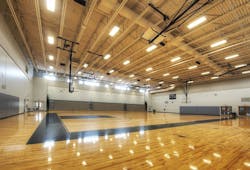During the summer months, janitorial staff at schools and universities across the country perform costly and laborious restorative gym floor maintenance to get them ready for the coming school year. But once school starts, how do you maintain that level of quality?
Gym floors take a beating during the school year. After multiple physical education classes each day, special assemblies, dances, band concerts and various other activities, maintaining that “summer clean” is difficult to do in a school – especially during winter sports season.
As one of the most heavily-trafficked areas in a school, the gym floor is also one of the most costly to replace. If not regularly cleaned and properly maintained, the cost of restoring and/or replacing a wood gym floor can run up to $100,000 in some cases. Whether your gym floor has a water-based or oil-based finish, proper daily maintenance is key to protecting your investment and extending the life of your floor.
Here are some strategies to help you protect and maintain your school’s gym floors through this busy winter season.
Step 1 - Protect
The first step in any floorcare program is to protect the surface from dirt and debris tracked in from the outside.
Schools without proper entrance matting will have a hard time keeping floors clean, especially during the winter season when soil accumulation is at its highest.
• Facilities with foot traffic of up to 1,000 people per day will have approximately 24 pounds of soil tracked in during a 20-day period.
• It costs $600 to remove one pound of soil from a facility, or 72 cents to remove the soil that is tracked in when someone enters your facility.
According to ISSA, facilities with foot traffic of up to 1,000 people per day will have approximately 24 pounds of soil tracked in during a 20- day period. Matting can reduce that number drastically. For example, six feet of matting at a facility’s entrance will remove 40 percent of soil, 12 feet of matting will remove 80 percent of soil and 36 feet of matting will remove 99 percent of soil.
The soil tracked in from outside of a facility will eventually make its way to the gym, so make sure your school has matting at each entrance, as well as outside the gym’s entrance and locker room. By keeping debris off of the gym’s floor, it is easier to maintain its finish – helping it to last longer and delay expensive restorative maintenance.
Also, be sure to maintain outside sidewalks and parking lots to lessen the amount of soil and debris tracked into your facility. Use scraper mats outside entryways to help “scrape” soil from shoe soles and provide an extra line of defense.
Your mat placement strategy can also help increase safety. When snow is on the ground, gym visitors may track in snow that will subsequently melt. Place mats along heavy traffic areas to capture excess moisture and help protect people from slip and fall accidents.
Step 2 - Maintain
Once you have protected the entryways, next you need to ensure that regular steps are taken to remove soil that does make its way into the gym.
Consider frequency of cleaning: A shiny gym floor is a healthy gym floor. One of the most important factors in maintaining a gym floor is dust mop frequency. When dirt and dust get tracked onto a gym floor, it grinds into the floors surface like sandpaper and creates bumps and crevices, damaging the floor and making it appear dull. To prevent as much dirt as possible from accumulating, be sure to dust mop after each use or gym class.
• 6 feet of matting removes 40% of soil
• 12 feet of matting removes 80% of soil
• 36 feet of matting removes 99% of soil
If your facility is short on staff and unable to dedicate an employee to cleaning the gym floor after each use, consider employing students to do the job on a rotating class basis. Also think about what tools you’re using. Keep dust and other particles off of the gym floor surfaces by using microfiber dust mops to clean the floor. Microfiber cleaning mops offer superior cleaning effectiveness and remove 80 percent more dust and dirt than traditional mops – leading to less debris and a longer lasting finish.
Even though microfiber mops offer superior cleaning quality, they do need to be cleaned on a regular basis. The good news is they are substantially easier to clean than traditional mops and can simply be thrown in the washer with hot water, an effective cleaning solution and other microfiber products. An alternative is to hire a firm that provides clean mops to your facility on a weekly basis.
But whether you wash your microfiber mop heads on site or use a professional laundry service, make sure they are cleaned often and according to manufacturers’ recommendations, as dirty mops do little more than push dirt around and can damage floors further by grinding dust and debris into the gym floor’s finish.
Failing to properly protect and maintain your school’s gym floor during the busy winter season can lead to costly restorative maintenance or even replacement. Whether you are in a public or private school, K-12 or post secondary institution, there’s a good chance that it will be tough to get the funds needed to either restore or replace a damaged floor. In order to maintain a high level of quality and extend the life of your floor, implement the above strategies and daily maintenance tips. Your gym floor should be a source of pride for your school, so keep it healthy and in good condition.
Mesko is Senior Director of Marketing for Cintas. For information on Cintas Facility Services, visit http://www.cintas.com/FacilityServices.

